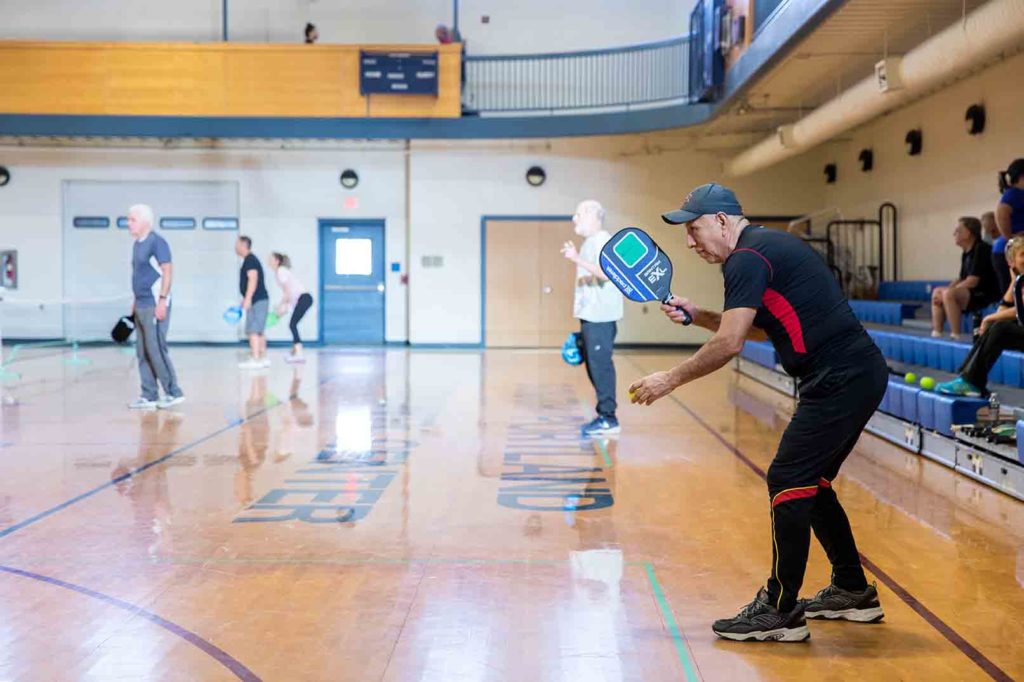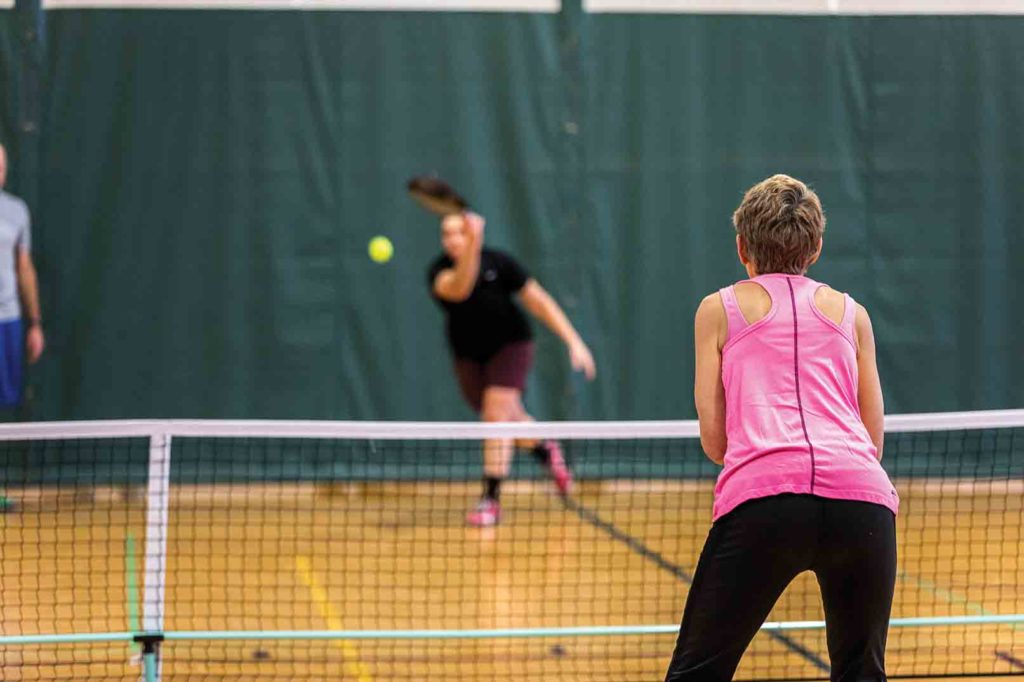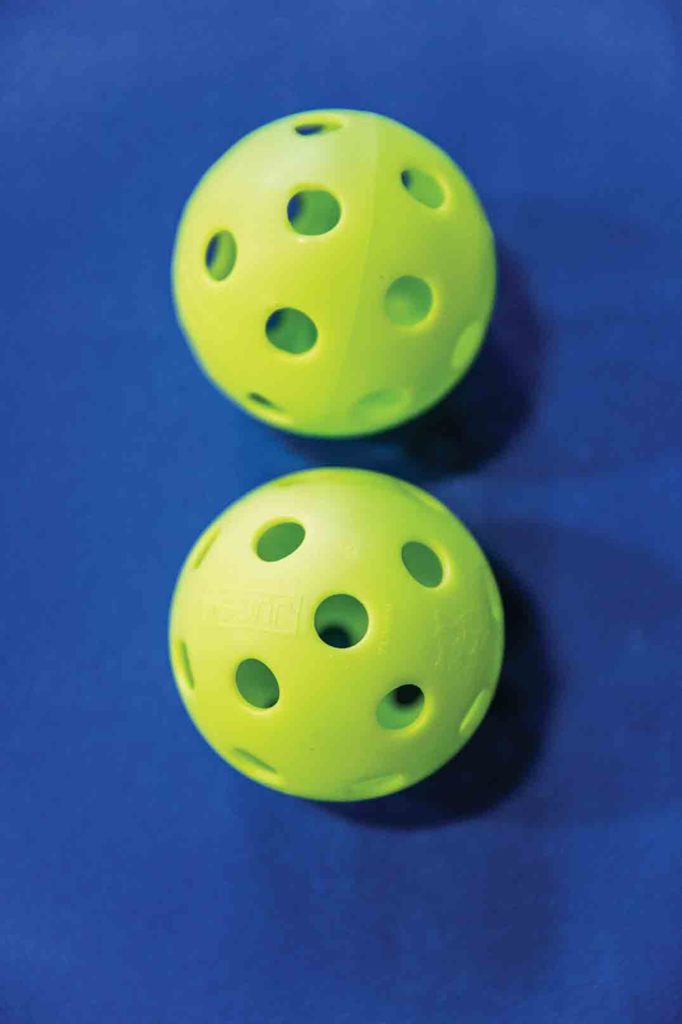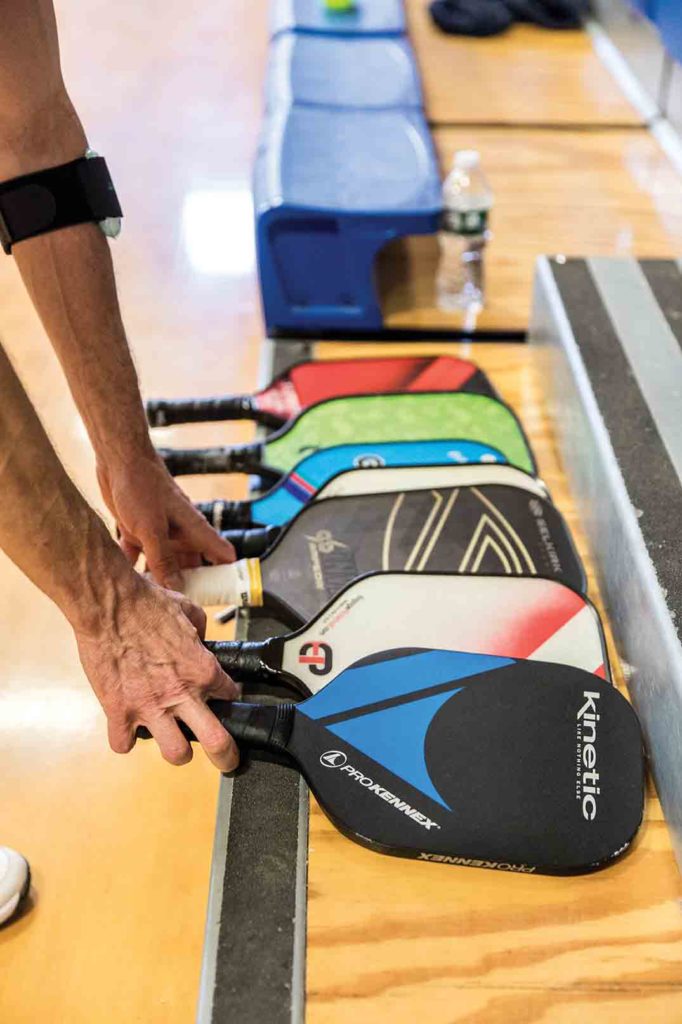Pickleball Picks Up Steam
The easy-to-learn paddle sport attracts all ages for fun and fitness

To allow for quick setup and breakdown, pickleball games are often played using portable net systems. Nets are positioned 36” high at the sides and 34” high in the middle. 
Tracy Burke has been playing pickleball for four years. The Cape Elizabeth resident manages the Southern Maine Pickleball Facebook page.
When I sat down with Tracy Burke, a freelance graphic designer from Cape Elizabeth, to learn the finer points of pickleball, I thought the bright yellow Wiffle-style ball in front of me told the whole story. This was my first error in under-standing the rapidly growing multi-generational paddle sport that is sweeping the nation. This is no Wiffle ball game; nor is it badminton or ping-pong, but it incorporates elements of each. “If you could shrink yourself down and stand on a ping-pong table to play, that’s what pickleball is,” says Burke, 54, who has been playing for four years, has competed in national tournaments, and manages the Southern Maine Pickleball Facebook page. This is a full-on, action-packed court game that is most definitely not restricted to the faint of heart or those inclined to be less competitive. According to the USAPA (the USA Pickleball Association) pickleball is “a paddle sport created for all ages and skill levels. The rules are simple and the game is easy for beginners to learn, but can develop into a quick, fast-paced, competitive game for experienced players.” Indeed it can, as I discovered watching one of the clips I found on the USAPA website of a pro team tournament. Holy moly, those players were quick-footed and could whack that little yellow ball.

I am not a paddle-sport player (yet). I was a miserable tennis player in my youth despite repeated attempts; instead, I found lacrosse to be my stick and net game of choice. I could run fast, shoot hard and didn’t have to master higher math to keep score. That said, pickleball appeals to me, as it did to Burke, a lifelong and collegiate basketball player. She describes the game as versatile, social, and a terrific community-building opportunity. It’s played on an easy-to-navigate court roughly the size of a badminton court (often a shortened tennis court). Serves are underhanded, the paddle is lightweight, and there is a No-Volley Zone (also called the “kitchen”), which is seven feet from the net on each side. Balls hit from inside the zone have to bounce first (so, no overhead smashes at the net). While understanding the scoring can be a challenge, new-to-paddle-sports players can be up and playing in no time (even unaccomplished ones like me). Most importantly—and this may be what is driving the sport’s popularity—pickleball is a game for all ages, all skill levels, all strengths, and all speeds.

While there is certainly a competitiveness to the game, pickleball’s rise could also be due to its compatibility for an age bracket on either side of retirement. It is decidedly physical but doesn’t have to be high impact. Excelling at the game could mean competing in regional championships and moving on to the national tournament regardless of which chronological decade one is representing. Or it can be played on a home court, a local YMCA, or a rec center with whoever has showed up to play that day. Most pickleball courts and programs in Maine are open play venues, which means if you want to play, you show up. Then, you put your paddle into the mix. In round-robin fashion, you get out on the court when the rotation provides an opportunity, and you play, usually doubles. You might know the person you play with, you might not. They might be your age, or they might not be. “It’s a wonderful milieu,” Burke says. “I have forged great relationships with people older and younger than I am through pickleball.” She credits Rocky Clark, of Portland, with introducing her to the game four years ago at a clinic he was holding to attract more players in the Portland area. Clark is apparently the pickleball guy of Maine. He serves as Maine’s USAPA pickleball ambassador and is also the USAPA Atlantic Regional Director who knows everything—and I mean everything—about the game. In the last eight years, says Clark, the number of players in the state has grown from the initial 30 who showed up at a clinic he offered to about 2,000. He speculates that the Atlantic Regional tournament, to be held in Portland in June, will draw 550 players and have “more impact on the city than a couple of cruise ships.” That’s a lot of pickleball.

Balls for indoor pickleball, made by Jugs, are engineered to play well on hardwood gymnasium floors. Indoor balls have 26 holes and outdoor balls have 40. 
At the end of a game, players tap paddles and say, “Good game!” Burke (in headband) taps paddles with (from top left) Sam Beal, Kichi Zarate, and Becky McHugh.
“Pickleball is a wonderful way to grow community, stay healthy, and support our orthopedic health,” says Clark. As a weight-bearing exercise, pickleball supports muscle strength, cardiovascular health, healthy weight, and all the other usual criteria for keeping the body healthy and flexible as long as possible. In addition, it requires fast footwork, quick reflexes, and some speedy mental acuity. The game’s dimensions, the ease of getting started, and the simplicity of the rule book keep this sport palatable and manageable for all ages.
As for the game’s origins and why it is called pickleball, there are a couple of competing stories. To set things straight: no, there are no pickles in pickleball. The game was created in 1965 by three dads outside of Seattle who needed to find something for their kids to do one slow summer day. With an old badminton net, some ping-pong paddles, and a Wiffle ball, the game was born. And then it evolved. Rapidly.

In 1976, the first pickleball tournament was held at the South Center Athletic Club in Tukwila, Washington. The participants were mostly college tennis players, new to the game, and eager to try something different. By 1984, the USAPA was formed; by 1990, the game was being played in all 50 states. In 2003, there were 39 known places to play in North America and 150 individual courts; by 2008, there were 420 places to play and 1500 courts. Today it is estimated that there are over 15,000 indoor and outdoor courts in the United States found in community centers, YMCAs, retirement communities, and school PE classes. Over 2,200 participants took part in the 2019 Margaritaville National Championships in Indian Wells, California, in front of 28,000 spectators over a ten-day period. In Maine alone there are now 109 places listed on the places2play.org page of the USAPA website. That doesn’t include the pop-up life of the game that happens with portable nets in people’s driveways, at camp-grounds, in school auditoriums, empty parking lots, retirement communities, or basically any place that can accommodate the 20′ x 44′ court and a net.

Pickleball paddles are engineered to suit every style of play. Similar to skis or surfboards, they are made of high-tech materials including honeycomb polypropylene, polymer, or Nomex cores, fiberglass, graphite, or carbon-fiber faces, and come in many shapes, sizes and weights. 
A backpack designed to hold paddle, balls, shoes, and water bottle.
Dink shot, Erne, the kitchen, around the post, capturing the net—these are part of my newfound paddle-sport vocabulary, along with the old block, drive, smash, rally and a few others that remind me of fruitless years on the tennis court, as well as those sweet summer evenings playing badminton in the backyard or rainy-day neighborhood ping-pong games in the garage. There is talk that soon pickleball games will be televised nationally, and, with a growing international participation, that it could become an Olympic sport. Wouldn’t it be grand for Maine pickleball players to represent with an all-ages team? What’s not to love about this game? Maybe there is hope for me yet.
For more information:
USAPA
Local USAPA Chapter
Southern Maine Pickleball Group

